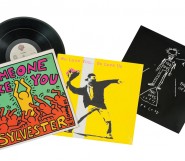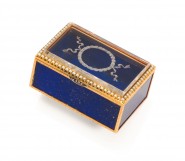Lot #10 - Bill Whiskey (Tjapaltjarri)
-
Auction House:Mossgreen
-
Sale Name:Australian Indigenous & Oceanic Art
-
Sale Date:21 Jul 2015 ~ 6.30pm
-
Lot #:10
-
Lot Description:Bill Whiskey (Tjapaltjarri)
(circa 1920-2008)
Rockholes near Olgas (2006)
synthetic polymer paint on linen
150 x 213 cm -
Provenance:Watiyawanu Artists of Amunturrungu, Northern Territory; Private Collection, Melbourne
-
Notes:Bill Whiskey's country lies to the north of Kata Tjuta (the Olgas), hidden in some of the most arid and uncompromising land on the continent. Long before his birth, Whiskey's father and grandfather would have become aware of the passage of a strange company through their country. While the explorer Ernest Giles saw only footprints he reported the 'natives were about' for they were 'burning, burning, ever burning',1 no doubt signalling the alien presence of the party and their packhorses. Giles noted the Pitjantjatjara 'perseveringly shunned us' fortunately for them, as it was the explorer's intention to 'catch a native' and 'walk him off alongside my horse until he took me to water'.2 Although there had been relatively few white incursions into this country by the time of his birth, the encroachment of the pastoral industry on land to the east had exerted a telling effect on Whiskey's people. From the late 1880's police were posted at Illamurta to protect the interests of the advancing pastoralists, pursuing any cattle killers far into the 'back country'. Most notable among the Mounted Constables was the notorious murderer W.H. Willshire and his intrepid successor, Ernest Cowle.3 Despite their vigilance, Western Desert warriors continued to spear cattle that fouled their precious water holes and fed their kinsfolk with the resulting abundance of meat from the kill. Family life was disrupted as warriors were tracked, chained and taken for trial in Port Augusta, where they were accused of the 'larceny of cattle'. A climate of fear descended, and Anangu (Western Desert people) continued to leave their country for the relative safety of mission-run ration stations.4 The country to the west and southwest of the MacDonnell Ranges was gradually depopulated, a trend that was exacerbated by the ravages of prolonged drought during the 1920s. Eventually, Bill Whiskey followed his countrymen out of an increasingly lonely land to outposts established by Lutheran evangelists on the margins of the desert. Whiskey and his family lived for a time at Areyonga, before moving further north to settle at Amunturrngu (Mount Liebig), then an outstation of Papunya. Whiskey was one of a handful of Pitjantjatjara men living in the vicinity of Papunya in the 1970s, and as a consequence was well aware of the painting movement and the controversies that surrounded the disclosure of secret sacred aspects of the Dreaming.5 Like his countrymen, who had migrated to southern communities, Whiskey chose not to participate in the first flush of contemporary desert art. In fact, it was not until 2005, when in his mid 80s, that Whiskey took up the brush. While Rockholes near Olgas is a compelling expression of Whiskey's abiding association with Pirupa Akla,6 it is intentionally cryptic, purposefully suffusing specific information about the Dreaming in a field of dots. Water places, such Pirupa Akla are powerfully marked by sets of concentric circles, their dazzling presence representing their life-giving significance, rather than their actual size. The actions of the White Cockatoo and Crow ancestors are encrypted as dotted patches that reference topographic features associated with the Dreaming.7 Whisky evokes the irregular pattern of vegetation that in traditional times resulted from fires set to hunt Mala (Rufus Hare Wallaby) and locate hibernating Tinka (Gould's Sand Goanna). The mosaic of coloured dots in Rockholes near Olgas echoes the treatment by Johnny Warangula Tjupurrula, (Tingari Men at Tjikarri, 1978, Araluen Arts Centre) reflecting similar land use practices in comparable country to the north.8 The minimal means of Rockholes near Olgas conveys the distance between landmarks in Whiskey's country, where isolated water places are concealed among cryptic patches of vegetation. Remaining true to the conduct of his ancestors, who had kept their distance from explorers, Whiskey protects the secrets of his country behind the abstraction of a vast plain, the refraction from shattered quartz and the smoke of signal fires. John Kean 1 Giles cited in Mike Smith, The Archaeology of Australia's Deserts. Cambridge University Press, 2013, pp. 302-303 2 Giles cited in Mike Smith, Peopling the Cleland Hills?: Aboriginal History in Western Central Australia, 1850-1980. Aboriginal History Monograph No 12. Canberra: Aboriginal History Inc. 2005, pp. 16-17 3 Mulvaney, Alison Petch, and Howard Morphy, From the Frontier: Outback Letters to Baldwin Spencer, Allen & Unwin, 2000, pp. 19-53 4 Mike Smith, 2005, pp. 29-65 5 The author knew Bill Whiskey as Art Advisor at Papunya Tula Artists, 1977-1979 6 Documentation for comparable works refers to Whiskey's 'birth' at Pirupa Alka however it is more likely that this is a 'borning place', the site where his mother felt his spirit quicken in her body, rather than the actual place of his birth. In Western Desert belief he is of that place and the totemic ancestors associated with it. 7 Nicholas Kachel, Bill Whiskey Tjapaltjarri, Coffs Harbour, John Gordon Gallery, 2007 8 John Kean, 'Johnny Warangula Tjupurrula: painting in a changing landscape,' Art Bulletin of Victoria, 2001, 41, pp. 47-54
-
Estimate:A$40,000 - 60,000
-
Realised Price:
-
Category:Art
This Sale has been held and this item is no longer available. Details are provided for information purposes only.










